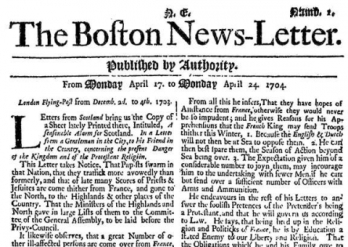Natalie Rohner
History of the Newspaper:
Are newspapers ‘old news?’ According to recent research 90 per cent of students do think newspapers are outdated and do not like reading print news. Instead they prefer to consume news from commercial television or online media.
But what would happen if no one read print news anymore? Print news has been an important influential factor throughout American history. The first successful newspaper was the Boston News-Letter.

Two more newspapers, one in Philadelphia and one in New York, made their debut in the 1720’s. Soon before the Revolutionary War, roughly two dozen newspapers were in circulation. The articles in these colonial papers were a major force that drove public opinion in America. Back then, reading the newspapers was a democratic responsibility.
Power of Framing:
However, even if students do not engage with print news anymore, newspapers remain relevant in the realm of politics. Newspapers still control public opinion through articles, news investigations, and photographs. Readers are able to become influenced by the framing mechanisms used by journalists. Because of this, political candidates invest enormous resources into controlling their messages during campaigns. Framing is an organizing device that journalists use in order to achieve persuasion over readers. Journalists use framing in order to create a particular narrative that sells a particular view point.
For example, there were two different frames existing around the Refugee crisis and Trump’s travel ban. On one hand, the travel ban was justified if framed in a way that made the issue of refugees strictly about the safety of the United States. By reporting that the safety of the United States would be jeopardized if refugees came into our country, some people would agree with this position out of fear. On the other hand, the story could be spun in a way that makes the refugees innocent victims who are not being welcomed into our country due to hate and racism. Below is an example of excerpt from a New York times article framing opposing opinions on Trumps travel ban:
“No citizen from the barred countries has carried out a fatal terrorist attack in the United States in the past two decades. That’s in part because the “extreme vetting” that Mr. Trump and his anti-immigration cabal have been hawking was already the law of the land.”
Image featured in New York Times Article
Newspaper Vs. Social Media
Before Trump shook up the world of politics during the 2016 election, the reportorial aspect of our media world was becoming a smaller part of the information people chose to see or read. This is due to the fact that now journalism rivals against the growing culture of commercial and social media. New media incorporates speed, entertainment and political affinity, which is difficult for newspapers to keep up with. Platforms such as internet blogs and social media sites are pushing traditional media aside and are quickly becoming the new influencer of politics. In order for newspapers to stay relevant in today’s media environment, journalists must expose the skeleton of their reporting. They must raise the bar of print news through verification and showing readers that they are a trustworthy source.
Sources:
Andy. “Students don’t read newspapers Shock!” AndyDickinson.net, 12 Mar. 2009, digidickinson.net/2009/03/12/students-dont-read-newspapers-shock/.
“A Brief History of Newspapers.” Newspaper History, http://www.historicpages.com/nprhist.htm.
Board, The Editorial. “A Trump Travel Ban We’ve Seen Before.” The New York Times, The New York Times, 25 Sept. 2017, http://www.nytimes.com/2017/09/25/opinion/editorials/trump-travel-ban.html.
Pettegree, Andrew. “Reformation and the Culture of Persuasion.” 2005, doi:10.1017/cbo9780511614613.

I found this post very interesting and informative. I have no idea that such a large amount of the younger generation believed that print media was outdated, 90% is a huge number! I think that it is interesting to compare where print media was to where it is today, because the popularity and following seems to have fallen drastically. It is almost more of a historical phenomenon now rather than a popular source for news.
It seems that in this generation that even print media is transitioning a ton to online platforms. I know that instead of subscribing to a print news paper I get my “newspaper news” from reading the online versions of the sources. My parents don’t even get the daily paper anymore. While newspapers may stick around for another decade or so I agree that they are no longer the main source for news and that online media is becoming more and more popular as the place to turn for the latest breaking news.
LikeLike
I found this post very interesting to read. This generation is moving towards recieving news through some platforms on the internet. I had the trend of paper print declining. I enjoy reading books in the physical form over e-readers. I also found the comparison on social media and newspapers very interesting.
LikeLike
This is a very interesting blog, I think it will be interesting to see what happens to newspapers in 10 years. In my opinion, they are still relevant but I do see how online news it becoming the new trend. It is surprising to me that so many younger people think that newspapers are not relevant anymore. My parents still read the newspaper every morning. I think as our generation gets older, the newspaper trend will continue to decline.
LikeLike